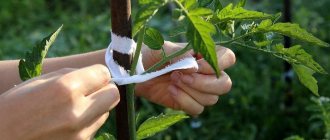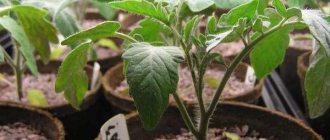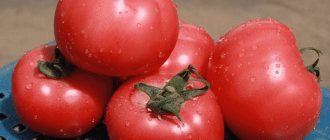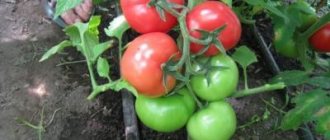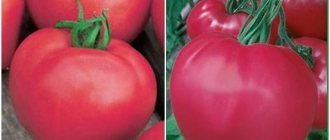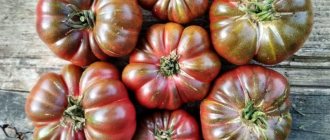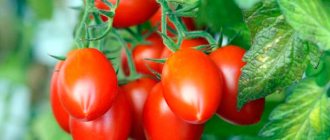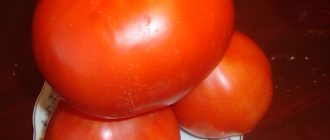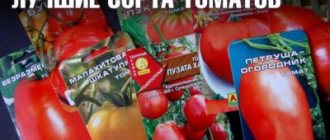National dragons became a source of inspiration when creating a variety for Chinese breeders. The trump card of the Black Dragon tomato is an abundance of chocolate cream with a neat shape and friendly ripening. An extremely easy-to-grow variety, it bears fruit consistently and richly.
| Height | Landing location | Ripening time | Fruit color | Fruit size | Origin | Fruit shape |
| Medium height | Greenhouse, Open ground | Ultra early | Black | Average | Variety | Plum-shaped or oval |
Tomato Phenomena: characteristics and description of the variety, the opinion of gardeners with photos
The hybrid tomato Phenomena F1 from the French company Vilmorin is becoming increasingly popular among vegetable growers.
It stands out not only for its amazing productivity, but also for its unpretentiousness. Egg-shaped tomatoes retain their presentation for a long time and look beautiful in the garden. Before sowing, experts recommend carefully studying the reviews of experienced tomato growers and the description of the Phenomenon F1 tomato.
Features of the hybrid
Tomato variety “Phenomena” is an early-ripening hybrid of the semi-determinate type. Full ripening of the fruit, under favorable conditions, begins within 95 days after germination.
Description of the plant:
- The bush is strong and spreading, reaching a height of 160–180 cm.
- A powerful root system contributes to the intensive formation of the plant and makes it more stable.
- The plant is highly leafy, which provides excellent protection of the fruit from the sun.
- Temperature conditions do not affect the quality of fruits and the intensity of fruiting.
- The hybrid has increased immunity to mosaic virus, verticillium, fusarium and stolbur, and is also less susceptible to yellow leaf curl and nematode.
Fruit characteristics:
- fruits are oval, ovoid;
- weight from 90 to 120 grams;
- The color of ripe tomatoes is deep red;
- the skin is strong, smooth, glossy;
- the pulp is dense, fleshy;
- tomatoes last a long time and do not spoil, maintaining their presentation;
- do not wrinkle during transportation and are resistant to damage.
Phenomena tomatoes are ideal for pickling, they make delicious homemade sauces, and they are also suitable for drying.
Growing and care
The Phenomena F1 tomato is recommended for growing both in greenhouse conditions and in open ground. Agricultural technology:
- It is recommended to sow seeds for seedlings in March, to a depth of no more than 1 cm. Afterwards, the seedlings should be watered with warm water, covered with film and placed in a warm place.
- After germination, the film must be removed and the container with the sprouts placed in a lighted place. For the first time, you can organize round-the-clock lighting using mirrors or fluorescent lamps.
- During the first week, it is desirable that the temperature in the room remains within +14–16 degrees. Afterwards the temperature must be increased to +20–22 degrees.
- When the first true leaf appears on the sprouts, the seedlings should be plucked.
- It is recommended to plant seedlings at the age of 35–40 days. The plants are unpretentious and take root easily.
- Tomatoes need periodic feeding with fertilizers containing nitrogen, phosphorus and potassium.
- Like all early ripening varieties, Phenomena does not require the formation of a bush, since the fruits ripen before the bush grows. The stems, although powerful, tend to bend under the weight of the fruit, so they need to be tied up.
Phenomena F1 is excellent for both growing in a summer cottage and for cultivation on an industrial scale.
High-yielding and long-storable tomato variety Monti F1
The Monti F1 tomato, reviews of which indicate the popularity of the hybrid among vegetable growers, is characterized by ease of cultivation, high yield and long shelf life.
Advantages of the variety
Tomato Monty F1 is a first generation hybrid. It appeared recently, but has already found its audience of fans who cultivate plants for the taste of long, aromatic fruits.
Breeders of this variety give a detailed description of tomatoes and note:
- average ripening period (from the moment of germination, the first mature fruit appears after 120 days);
- resistance to drought (an ovary forms on the bush when there is a lack of moisture);
- compactness of the bush;
- large leaves;
- high and consistent yield (12 kg per m²);
- unripe tomatoes ripen in a dark place, maintaining their taste;
- fruits are resistant to transportation over distances;
- preservation of presentation.
The excellent characteristics of the plant make it possible to cultivate Monti tomatoes in open ground conditions. In the case of growing crops in film greenhouses without heating, vegetable growers recommend reducing watering.
The fruits of the plant are egg-shaped and rich red in color. The tomato weighs 100 g, the skin is dense, and the stalk does not have a green spot. The fruits have 3 seed chambers.
Tomatoes have a pronounced aroma and a sweet and sour taste. Ripe tomatoes are dense and have a high concentration of dry matter. In cooking, the fruits are used raw and canned.
Agrotechnical cultivation conditions
Caring for a hybrid tomato variety involves a set of measures that ensure a high yield. Sowing seeds for seedlings is carried out in mid-March. To ensure vigorous germination, the seeds are treated in an aqueous solution of potassium permanganate.
Seeds are planted in a container with prepared soil. It is recommended to additionally illuminate the seedlings with an electric lamp for up to 18 hours a day so that the seedlings become stronger and do not stretch in height.
During the formation of the first true leaves, plants are fed with complex mineral fertilizers for seedlings. To strengthen the planting material, hardening and ventilation are periodically carried out.
During the entire growing season, plants are given moderate watering. Planting in a permanent place is carried out in May, after the end of the frost period.
To increase crop yields, the soil is mulched using special black agrotechnical fiber, sawdust or grass.
To harvest a high yield of Monti tomatoes in greenhouse conditions, you will need drip watering of the plants, which optimizes water consumption and prevents liquid from getting on the leaves.
The fruits of the first harvest are large, and then they become small; it is recommended to completely remove the tomatoes before August. Tomatoes growing in open ground ripen well in a dark place.
Recommendations from vegetable growers
Due to its resistance to various diseases of nightshade crops (verticillium, gray spot), the Monti variety is popular among vegetable growers. Positive reviews are associated with excellent taste and long shelf life.
The hybrid is included in the State Register of Vegetable Crops; it is recommended to grow it in private gardens and on personal subsidiary plots.
Maria Eremenko, 49 years old, Omsk:
“I often experiment with growing different varieties of tomatoes in my garden. Last year, on the recommendation of colleagues, I sowed a bag of Monti hybrid tomatoes for seedlings. The result was pleasing, all the seeds sprouted, and seedling loops appeared together.
During the cultivation process, the main thing is to follow the instructions, and the result will fully correspond to the description. The fruits set, regardless of air temperature. The simultaneous ripening of the fruits allows you to harvest a bountiful harvest from the bushes.”
Vasily Proklov, 67 years old, Biysk:
“I’ve been cultivating tomatoes for many years.
The Monti variety attracted attention for the shape of the fruit, aroma and long shelf life. The fruits have an oval shape and thick skin
Tomatoes picked green ripen well in warm conditions. At the same time, their taste is preserved.”
Source https://moefermerstvo.ru/tomat/vyrashhivanie/monti-f1
Tomato "Yablonka Rossii" - an early ripening variety for open ground
“Apple Tree of Russia” is only slightly inferior in popularity to the “Sanka” variety. To some extent, these are competing varieties - both were created for open ground, both are early ripening and both give a good harvest for open ground. True, in my opinion, “Sanka” tastes better. However, first things first.
The tomato variety “Yablonka Rossii” was bred by it is not entirely clear who. The list of authors includes the name of Vladislav Korochkin, the president of the group, but it is unlikely that he himself was involved in selection work. Viktor Anatolyevich Vasilevsky from the All-Russian Research Institute of Selection and Seed Production of Vegetable Crops and other specialists are also mentioned among the co-authors. The originator of the variety is NK LTD, which is directly related to the Russian Vegetable Garden.
The variety was registered in the Register in 2000. It also went on sale around the same time.
In the 90s, the Tamina tomato variety, which was quite similar in appearance to YAR, was quite popular. Sometimes both names are indicated on seed packets. In the Register, however, the Tamina tomato variety is not mentioned anywhere.
Characteristics
| Type | determinant |
| Plant height | about 100 cm |
| Fruit | Round, smooth, weighing up to 80 grams, red |
| Taste | good |
| Ripening period | early, about 90 days |
| Disease resistance | no convincing data |
Description
“Yablonka Rossii” is a determinate, medium-growing variety. The height of the bush is usually about a meter or a little more, but in greenhouses some amateur gardeners have it. This is a standard tomato: “Apple tree” forms a fairly compact bush with a thick stem and medium-sized “potato” leaves. The tomato, of course, needs to be tied up, but it’s quite late.
The first inflorescence is laid over 7-9 leaves, the subsequent ones - after 2 leaves. Inflorescences can be simple or intermediate (with one branch), the stalk with an articulation.
Tomatoes “Yablonka Rossii” are round, with a smooth surface, weighing up to 80 grams. Unripe tomatoes are light green, ripe ones are deep red. Nest with seeds. The taste is good. Recommended for use for whole-fruit canning, but also suitable for salads and for processing into pastes.
Features of cultivation
The “Yablonka Rossii” tomato is approved for cultivation in all regions of the Russian Federation as a variety for open ground. I grew it in 2015 and plan to grow it in 2021. It is a fairly unpretentious and stable variety.
The 60 x 50 planting scheme worked well. I fully formed some plants into three stems, and some I didn’t plant at all. There were only a few specimens in each group: therefore, unambiguous conclusions cannot be drawn, but in general, the non-stepchildren seemed to me more productive. By the end of August, absolutely all the tomatoes had time to ripen, but August 2015 was very hot.
The variety is early ripening - ripening begins approximately 90 days after emergence, even in open ground. Probably, in a greenhouse you can get a harvest even earlier.
The register states that the variety is characterized by uniform ripening of fruits, but for me the fruiting and ripening were rather extended. Productivity according to the register is 5.3...5.6 kg/m2. I didn’t document the yield on my bushes, but I feel like each plant produced at least 2 kg of marketable tomatoes. In terms of per square meter this will give more than 6 kg.
Advantages
- possibility of growing in open ground;
- ease of cultivation;
- early ripening;
- uniformity of tomatoes in size;
- relatively high yield.
Description of the Cornet tomato and recommendations for growing it in the garden
The plant is not very demanding of moisture; it usually needs 3-5 waterings per season. The rest of the time, the variety receives moisture from rain. The most important watering is with the appearance of the first shoots with leaves and at the beginning of flowering. The soil is spilled 50 cm deep with slightly heated water.
Feed 3 times.
Fertilizers are not applied to dry soil so as not to cause burns to the roots. The optimal time for them is after watering.
Young plants need nitrogen, preferably from organic fertilizers in low concentrations. During the flowering period, potassium and phosphorus are added. At the end of flowering, you can spray the tops with a weak solution of superphosphate.
Twice a season, while the bushes are young, they are spudded.
The characteristics and description of the variety are as follows:
- The first harvest of Cornet tomato is obtained 85-90 days after seed germination.
- The height of the tomato bush is 0.45-0.5 m. An average number of green leaves develops on the stem.
- Each cluster produces 4 to 5 fruits.
- In an agricultural catalogue, the description of a plant's fruit begins with its shape. Tomatoes look like a ball with a smooth side surface. Ripe fruits are painted in bright shades of red.
- The weight of the fruit ranges from 0.1 to 0.11 kg. The skin and pulp of the Cornet tomato have increased density. There are 4-5 seed chambers inside the fruit.
Reviews from farmers who planted the described variety show that its yield is 3.8-4.2 kg of fruits per 1 m² of bed. Most gardeners grew Cornet in open ground, so the indicated yield figures can be significantly improved if the crop is grown in a greenhouse.
Vegetable growers note the friendly ripening of the plant’s fruits. Due to the early ripening period, Cornet is not susceptible to late blight. As almost all farmers note, the tomato variety described is unpretentious to growing conditions. The bush takes up little space, which allows for maximum compaction of plantings. The density of planting bushes in the beds has virtually no effect on the formation and development of ovaries.
Trading companies willingly buy Cornet from the population, since its fruits can be transported over any distance.
That part of the people who planted Cornet in their garden plots indicates that due to the small growth of the bush, it is not necessary to tie up the stem of the plant or remove the stepsons.
To obtain the desired harvest, it is recommended to fully comply with all agricultural technology requirements recommended by the tomato developer. To cultivate Cornet, you need to buy tomato seeds in branded stores selling agricultural products.
Seedlings begin to be grown approximately 45-60 days before the planned planting of plants in the ground. The exact time of this operation depends on the place where the gardener lives. Most often this happens at the end of March or mid-April. If the region is characterized by early spring, then the seedlings are grown in greenhouse blocks without heating.
Before planting in pots with soil, seeds are treated with potassium permanganate. They are buried 10-15 mm into the soil. After 2-3 leaves appear on the seedlings, the sprouts dive. A week before transferring the bushes to permanent soil, they are hardened off.
The beds for planting are prepared in advance. To do this, the soil on them is loosened, organic and nitrogen fertilizers are added to the soil. Cornet is planted in a 0.4×0.6 m format. It is recommended to plant 3-4 plants per 1 m² of bed.
If the weather is humid, then cover the bushes with film. The ends of the film coating are left free. For the first 3 days, young plants are protected from sunlight. In order for the bushes to grow together and not get sick, it is necessary to mulch the soil.
During the entire growing season, you should feed the tomatoes 2 times with fertilizers containing nitrogen, potassium and phosphorus.
Watering the bushes is carried out with warm water in the early morning. This requires a moderate amount of liquid. To prevent plants from getting sick, their leaves are treated with the drug Fitosporin. It is recommended to destroy garden pests with chemical poisons.
Tomatoes are a valuable plant crop that has gained recognition throughout the world. The demand for tomatoes is associated with their beneficial properties, good taste and ease of cultivation. Tomato Cadet is one of the worthy representatives of the nightshade family. The work of Russian breeders from a large agricultural company has found its admirers in different regions of the country.
Growing the variety
Growing a Cutie tomato is possible in different ways:
- mixborder seeds directly into open ground;
- preliminary germination of seedlings.
The characteristics of the variety allow gardeners to feed seeds in open ground. The seed is placed on the plot, leaving a small gap between each other.
Germinating seeds in open ground is not a condition for successful growth and fruiting. The Cutie variety can be sprouted on a windowsill. The superelite is placed in small containers with a nutrient mixture, moderate watering and good electricity are maintained. A plant that has grown 2 permanent leaves can be planted in open ground.
Agronomists advise germinating seeds at the end of April - beginning of May, regardless of the chosen method.
Description of the variety
Miracle fingers differ from other cherry tomatoes in the elongated shape of the fruit. Other characteristics include high yields and easy care. You can cultivate this tomato in open ground without bothering yourself with forming a bush and pinching. Tie it to a support if necessary.
Tomatoes on the bush grow in large clusters. They have an original and rather pleasant appearance: oblong, with a slightly pointed tip. These fruits are equally good for canning as a whole (the small size is very convenient for such purposes), and for using fresh in salads and for decoration (small red cherries look very beautiful on a dish). The variety is also suitable for consumption in dried and dried form.
This tomato does not need a greenhouse, but it grows well and bears fruit on balconies and loggias in small containers.
According to ripening time | By type of growth | By type of use | By growing method | Fruit weight (g) | Productivity (kg/m2) | Fetal characteristics |
| Mid-early (95-110 days) | Determinant (50-60 cm) | Universal | For open ground | 20-30 | up to 6 kg | Elongated, red, small in size, sour-sweet |
Growing tomato Countryman
The Countryman tomato is usually grown through seedlings, but in warm climates it is possible to plant the seeds directly in open ground.
Rules for planting tomato seedlings Zemlyak
Since the ripening period for this tomato is approximately 3 months, vegetable growers in the southern regions of Russia do not grow Zemlyak seedlings
, and immediately plant the seed in the last ten days of April - the first ten days of May in the beds. And already in the last ten days of July, the harvest of ripe fruits is harvested.
In other Russian regions it is necessary to grow this tomato in seedlings.
. In this case, seed material is planted in the last ten days of March. Since about 60 days should pass from the moment of seed germination to the planting of Zemlyak tomato seedlings in open ground, the specific sowing period is calculated based on the climatic conditions of the growing region - by the time of transplanting to garden beds there should be no return spring frosts.
Tomato variety Countryman in open ground - video
Soil for planting seedlings is bought in a specialized store, and seeds collected from your beds should be disinfected in Bordeaux mixture before planting and then germinate. And only then sow.
Seed material is planted in wide, low containers. At the stage of a pair of permanent leaves, the plants are picked, transplanted into a separate container.
One of the advantages of the Zemlyak tomato variety is that the grown seedlings are not prone to overgrowth. However, even before transplanting the seedlings to a permanent place, buds may appear on them, which may fall off during transplantation and further acclimatization of the plants. Therefore, it is advisable to plant seedlings before flowers appear on them.
Important!
7-10 days before transplanting, the seedlings of this tomato must be hardened off: on a balcony, loggia or outside on a warm day.
Planting seedlings in a permanent place
Seedlings are planted in beds prepared in advance. The main thing is that the soil in them is well fertilized.
5-6 tomato bushes are planted on each square.
The plants are strong and not too tall, so some vegetable growers do not tie up the shoots. However, under the weight of ripening fruits, the stems may fall to the ground. Either you have to lay a thick layer of straw under the bushes so that the tomatoes do not come into contact with the soil, or put supports to which you tie the shoots in several places.
Technology for growing tomatoes of the Yellow Dragon variety
Since the Yellow Dragon tomato variety is mid-season, seeds are planted 65 days before the expected day of planting the seedlings in the ground. The soil for cultivation is prepared in advance in the fall. It is carefully dug up and, if necessary, the necessary fertilizing is applied in the form of mineral and organic fertilizers. It is also necessary to select a site for planting in advance. It is necessary to exclude those places where potatoes, peppers and other tomato varieties previously grew. It is allowed to plant tomatoes in areas after cucumbers and cabbage.
The first step in growing a tomato is to plant the seeds. They are planted in special containers, containers or disposable containers. The substrate is placed in them at a level slightly more than halfway. Next, the soil is moistened, furrows are made and the seeds are placed infrequently to prevent the seedlings from stretching out.
To ensure that the sprouts appear quickly and are uniform, before planting, the seeds can be treated with growth preparations and soaked in a weak solution of potassium permanganate for disinfection.
Note! It is advisable to choose containers for planting seeds with small holes at the bottom or side to allow gas exchange to take place.
After containers with seeds can be covered with plastic wrap. It is removed after seed germination. Care during the development of seedlings is carried out as necessary.
As soon as real leaves begin to grow on the sprouts, the seedlings become stronger and gain strength, you can begin replanting in a greenhouse or open ground. To do this, small holes are dug in a previously prepared area. They are moistened and the sprouts are immersed to the level of the leaves. Then they are covered with earth and not compacted too much.
For better growth and development of the tomato, it is advisable to form the bush into 2 or 3 stems. When digging holes, intervals should be observed. The distance between the bushes should be 40 cm, and between the rows at least 0.5 m. This will allow the plant to grow comfortably and make it easier to care for the plantings.
Positive aspects of the variety
Even a novice gardener will be able to get a good harvest of tomatoes by planting Cutie in his summer cottage, thanks to a number of positive qualities:
- Unpretentiousness. This variety is unpretentious. Growing it does not require any special skills, and any summer resident can handle its care.
- Resistant to low temperatures. Many varieties of tomatoes die at the slightest drop in temperature, which is typical for the spring period. This does not interfere with the active growth of the Milashka variety and the development of fruits.
- Compactness. 9 bushes fit on 1 square meter, which guarantees a large harvest of tomatoes.
- Disease resistance.
- High yield. Gardeners harvest about 20 kg of berries from 1 square meter.
- Good taste. The taste characteristics allow this variety of tomatoes to be used for preparing any dishes and preparations for the winter.
Thanks to many positive qualities, the Milashka variety has earned the trust of not only experienced and novice summer residents, but also professional agronomists whose goal is to obtain a large harvest with a minimum of effort.
Reviews about the Cutie tomato
Maria from Nizhny Novgorod: “I grew Cutie last year and was pleased with the result. The fruits are small, neat, and placed in jars for pickling. The taste is excellent, I grew it in the garden, so it turned out sour.”
Vladimir from Minsk: “I bought a pack to try five years ago. Now every year I grow Cutie from my seeds. I am satisfied with the growth characteristics: excellent germination, high yield. Thanks to the compactness of the bushes, I get a high yield in a small area.”
Characteristics and description of the Polbig tomato variety, its yield
With the onset of spring, the “hot” season begins for summer residents; it is necessary to prepare in advance for the start of agricultural work. The Polbig tomato is suitable for those gardeners who want to get early tomatoes from their summer cottage.
Polbig is a hybrid variety that was bred by Dutch breeders. Refers to early ripening nightshade crops. From the appearance of the first shoots to the ripening of the crop, about 95-115 days pass. Perfect for growing both in open ground and in a greenhouse. The height of the bushes can reach up to 65 -85 cm. It tolerates cold weather well.
Polbig F1 tomatoes are classified as determinants (low-growing varieties). It is characterized by high resistance to various diseases, especially fusarium, alternaria, and verticillium. Due to the fact that the hybrid is an early ripening hybrid, it is not affected by late blight.
If you follow all the rules of agricultural technology, the yield of this variety will be quite high. The main advantage of the hybrid is that even at low temperatures it is capable of producing a large number of ovaries. This quality makes the hybrid one of the most attractive for cultivation in the northern regions.
Reviews on various thematic forums for this variety dedicated to gardening are mostly positive. What many gardeners like about this hybrid is that already in mid-July you can find blushing tomatoes on the bushes.
Description of the variety:
- High yield;
- The bushes are quite compact, not branched;
- From one bush you can collect from 3.5 to 4.5 kg of ripe fruits;
- The leaves are quite large, dark green in color;
- As the bushes grow, they need to be tied up;
- Requires stepsoning;
- The inflorescence of the Polbig tomato is classified as simple;
- Unripe fruits are light green in color;
- As tomatoes ripen, they acquire a rich red color, without green spots;
- The surface of the skin is smooth, slightly ribbed;
- The shape of the fruit is round;
- The weight of ripe tomatoes can reach up to 210 g (in greenhouse conditions - 110 g);
- The pulp is dense, aromatic, quite dense;
- Perfect for making sauces, lecho and various salads;
- Characterized by high resistance to the development of common diseases;
- Due to its early ripening, the variety is one of the first to appear on shelves and the market.
Advantages:
- Precocity;
- Ovaries can form even at low outside temperatures;
- Refers to highly resistant varieties, especially Fusarium, Alternaria, and Verticillium;
- Due to their thick skin, ripe tomatoes do not crack;
- Seedlings can be planted even in northern regions;
- Well preserved during transportation.
Flaws:
- Due to the fact that the hybrid is an early ripening tomato, the taste is mediocre;
- The bushes need to be tied up so that the stems do not break under the weight of the tomatoes;
- Requires stepsoning.
Despite the fact that this variety of nightshade has many advantages, ripe tomatoes do not taste very pleasant. They are not suitable for fresh consumption; it is better to use them for preparing tomato juices or canning.
Growing the Polbig hybrid is not particularly difficult.
Recommendations for growing seedlings:
- Planting material must be grown in small containers, having previously filled them with a mixture of peat and soil;
- After several leaves appear on the bushes, they need to be picked;
- Before planting seedlings in open ground, it is recommended to harden them;
- To plant seedlings, it is advisable to choose areas where zucchini, cauliflower, cucumbers, carrots or dill previously grew.
Seeds should be planted in late March - early April. After two months, the seedlings can be planted in open ground. The distance between the bushes should be approximately 35-50 cm. At first the bushes will be very weak; to accelerate their growth, they must be watered with the preparation “Kemira” or “Solution”.
Tomato Harlequin f1: variety description, photo
The Harlequin f1 tomato was created by Russian breeders. This plant is mainly grown in greenhouse conditions. Tomatoes of this variety are early ripening. To decide for yourself whether or not to grow this variety, you need to know the description and characteristics of the tomato.
Description of Harlequin tomatoes
Characteristics of the Harlequin f1 variety:
- Harlequin tomatoes are a hybrid variety;
- the plant is intended for growing on small farms and in summer cottages;
- tomatoes are grown in film shelters in spring and summer;
- the tomato tolerates the climate of Moldova, Ukraine and warm regions of the Russian Federation well;
- after the emergence of seedlings, the harvest can be harvested after 3 months;
- From the moment the seedlings are planted until the fruits appear, about 112 days pass.
Harlequin is a determinate variety. Plant height is average. The stems have a small number of leaves. The leaves are small and dark green. Bushes are formed into 1-2 stems. The height of the plant is 120-150 cm. The first ovary appears above the 7-8 leaves of the tomato. The next inflorescences are formed after 1-2 leaves. Up to 9 tomatoes ripen in 1 cluster of plants. The fruits are round in shape, slightly flattened at the top and bottom.
The fruit has ribs at the top. The fruits have juicy, dense pulp. Unripe tomatoes are green in color. Ripe tomatoes are bright red in color. The weight of 1 tomato is 150 g. The fruit has an excellent taste. In 1 season, gardeners can harvest up to 10.7 kg of crop from 1 m² of soil.
If the plants were grown using agrotechnical measures, the yield of this variety reaches 42 kg per 1 m² of soil. Plant care measures include fertilizing the soil with mineral and organic fertilizers, loosening the soil, rare but intensive watering, and removing weeds.
Tomato is resistant to diseases such as late blight, fusarium and other fungal diseases. These tomatoes are universal in their use: they can be used raw, for salads, pickling, pickling, making juice, gravy, sauces, seasonings, and various hot dishes. Tomatoes can be salted, canned, fried, boiled, stewed.
Reviews from gardeners who grew this variety are positive. Vegetable growers note that the fruits ripen early and the yield is high. The fruits are quite large, inflorescences appear even in bad weather.
As gardeners note, seeds should be sown for seedlings at the end of March. After the formation of 1-2 leaves, the stem is picked. The sprouts are removed from the common container and planted in peat pots.
According to the recommendations of vegetable growers, plants should be planted in the ground according to a 50x40 cm pattern. At the same time, up to 9 bushes are planted per 1 m² of soil. Harlequin tomatoes can be planted in special shelters made by stretching film over arches, or in ordinary greenhouses. Plants can be planted in an open garden bed only in warm areas. When growing, the beds should be well lit by the sun. Tomatoes can be grown in an area where cucumbers, carrots, cabbage or dill previously grew.
Characteristics
Tomatoes of the Dutch hybrid "Tanya" are distinguished by abundant fruiting and excellent yield. The fruits are not too large, weighing on average 150-170 grams, bright red, round in shape, dense and strong. There are 4-5 pieces on a brush. The first inflorescence is formed above the 6-7 leaf, and the subsequent ones - every 1-2 leaves. The fruits are rich in vitamins, especially vitamin C, and contain a lot of sugar and solids.
You can compare the weight of the fruits of this variety with others in the table below:
| Variety name | Fruit weight |
| Tanya | 150-170 grams |
| Golden Stream | 80 grams |
| Pickling miracle | 90 grams |
| Locomotive | 120-150 grams |
| President 2 | 300 grams |
| Leopold | 80-100 grams |
| Katyusha | 120-150 grams |
| Aphrodite F1 | 90-110 grams |
| Aurora F1 | 100-140 grams |
| Anyuta F1 | 95-120 grams |
| Boni M | 75-100 |
Tomatoes are light, transportable, and can be stored fresh for a long time. Tomatoes "Tanya" at the stage of green technical ripeness do not have a green spot on the stalk. This is the main distinguishing feature of the variety.
Tomatoes "Tanya" will satisfy any culinary needs. Due to the fact that the fruits are not large and dense, they are good both fresh and in a variety of vegetable salads, suitable for processing, for making tomato juices and pastes, they are very good when salted and pickled.
Tomato Verlioka F1: advantages of the variety
Tomatoes Verlioka: photo of the variety
Verlioka tomatoes form ovaries very amicably. They also ripen at the same time. Which is undoubtedly convenient when harvesting. The fruits do not differ much in size. That's why they are so good for preservation. As a rule, there are 5-10 tomatoes on one branch. The fruits are bright red, round in shape. With a fairly thick skin. It is thanks to this density that Verlioka F1 tomatoes rarely crack while they ripen. The taste of tomatoes is quite sweet, with a slight sourness.
The tomatoes of the Verlioka f1 variety themselves are not very large, as a rule, from 70 to 100 g. If you follow all the rules of agricultural technology, you can harvest 5-7 kg of tomatoes from one bush (in a greenhouse). This means that from each square meter you will collect more than 20 kg.
Another wonderful quality is that picked green tomatoes ripen quite quickly at home in the dark. Experience shows that not every variety has this quality.
So, among the undoubted advantages are the following qualities:
- early fruit ripening;
- good yield of Verlioka tomatoes;
- a large number of ovaries on one plant;
- lack of response to small temperature changes;
- immunity to “tomato” diseases;
- friendly formation and ripening of fruits;
- ability to grow in light shade;
- universal use in cooking;
- the ability of tomatoes to reach maturity after being picked from the plant.
Tomato Funtik - description and characteristics of the variety
Most gardeners and farmers prefer to grow hybrid tomato varieties. The tomato variety Funtik is included in the State Register and is distinguished by the presence of large fruits. Tomatoes have excellent taste, can be consumed fresh, and are suitable for all types of processing. In open ground, the Funtik variety is grown mainly in the southern regions; in other regions it is recommended to use greenhouses.
Description of the variety
This is a medium ripening hybrid. The bushes grow from 1.5 to 2.3 meters. The leaves are dark green in color, similar in appearance to potato leaves. The first ovary appears above the 9-11th leaf. The bushes must be tied to an installed support. Inflorescences are formed in clusters, 4-6 tomatoes in each. The fruits have different shapes: from flat-round to slightly ribbed. The weight of one tomato varies from 180 to 230 grams.
Tomatoes are well transported over long distances without losing their marketable appearance. Thanks to their thick skin, tomatoes can be stored fresh for a long time. There are no more than 4 plants per square meter. The variety is characterized by high yield; up to 10 kg of ripe fruits can be collected from one bush. To obtain a richer harvest, it is recommended to form a bush with 1 stem.
Diseases and pests
The Funtik variety is quite resistant to viral tobacco mosaic and fusarium. However, for preventive purposes, bushes can be treated with special preparations. Fungi can infect plants for the following reasons:
- Use when sowing infected seeds.
- The dangerous virus was in the soil for sowing and diving.
Before sowing, it is recommended to disinfect the soil. To do this, the soil is calcined at high temperature in the oven or on the stove for 2-3 hours. You can pour boiling water or a solution of potassium permanganate into the soil. It is also recommended to soak the seeds in a manganese solution. A good way to get rid of pathogens and pest larvae is to loosen the soil after planting and timely removal of weeds. Experts advise regularly inspecting bushes for lesions and infestations of harmful insects. Once signs are detected, chemical spraying should be carried out.
Rules of care
In order to get the highest possible tomato yield, it is recommended to follow the rules of care. The bushes should be watered with warm, settled water in the evening. The soil should not be over-moistened, otherwise the roots may begin to rot. Several times during the summer it is necessary to apply complex organic and mineral fertilizers. The bushes must be pinched and the lower leaves must be plucked off in a timely manner. If plants are grown in a greenhouse, it should be ventilated regularly.
If you properly care for tomatoes throughout the season, you can get wonderful harvest results.
Efim Danilovich, 61 years old:
A very good variety Funtik. I surprised all my dacha neighbors with the resulting harvest. I collected more than 10 kg from one bush. The tomatoes are very tasty and meaty. The pulp is juicy, thanks to the durable skin, the fruits can be stored fresh for a long time. My family ate healthy tomato salads until the frosts. Caring for bushes is not difficult. It is enough to form a stem, tear off the stepsons and tie the bushes. Then you need to water, loosen the soil and apply fertilizer. The result obtained completely justifies the time spent.
Angelina V., 51 years old:
I grew the Funtik variety at my dacha in a greenhouse. I got a good harvest. I made sauce, juice and lecho. Whole tomatoes were not suitable for canning because the fruits grew too large. Fresh vegetable salads are very tasty, thanks to the aromatic tomatoes. I will definitely always grow this variety. It is important to remove weeds and add nutrient mixtures in a timely manner. This has a beneficial effect on the development of tomatoes.
Rules for caring for plants
You can achieve a high yield of Yellow Dragon tomato if you take proper care of the plants. Tomatoes need timely watering, mulching, applying mineral and organic fertilizers, weeding holes, loosening the soil, as well as controlling diseases and pests.
Tomatoes of the Yellow Dragon variety should be watered with water at room temperature. Watering should only be done under the root system. Liquid consumption per well is up to 1 liter. In hot weather, watering can be carried out more often, but in rainy weather, it can be completely absent. It is especially not recommended to flood the plant after transplanting it into open ground, so as not to provoke the development of blackleg, rot and other diseases. For the same reason, it is important to choose areas for planting tomatoes where there are no depressions or depressions to avoid stagnation of water.
It is recommended to weed the holes and hill up the soil after each watering. Mulching should begin after 12-14 days from the moment of transplantation. And this procedure must be repeated every 2 weeks. Along with mulching, the bushes are tied to supports. They protect the plantings from unfavorable environmental conditions and help the plant survive the harvest.
Fertilizers should be applied at least 3 times during the entire growing period. For this purpose, mineral and organic substances are used. They use potassium, manganese, phosphorus preparations, nitrogen, superphosphate, wood ash and other components. All of them help the rapid growth and good development of fruits.
Pest and disease control is carried out using chemicals. Such procedures must be carried out regularly as a preventive measure. Good care and feeding of seedlings also help prevent diseases.
A delicious decoration for the greenhouse - the Yellow Date tomato: description of the tomato variety, care features
Gardeners who have a greenhouse on their property should pay attention to the sweetest varieties of tomatoes intended for growing indoors. A tall variety that requires the formation of a bush with 2 stems and the removal of numerous stepsons
Tomatoes take about 4 months to ripen. The fruits are shaped like barrels with glossy yellow skin. The weight of an average tomato is 200 g. It received its name for its similarity to honey in color and taste of the pulp.
A tall variety that requires the formation of a bush of 2 stems and the removal of numerous stepsons. Tomatoes take about 4 months to ripen. The fruits are shaped like barrels with glossy yellow skin. The weight of an average tomato is 200 g. It received its name for its similarity to honey in color and taste of the pulp.
Valued for the original color and sweetness of the fruit. Large, round, yellow fruits have bright red spots over the entire surface of the peel. It takes at least 4 months from sowing seeds to harvesting. The plant needs constant formation of a tall bush and support. Productivity 6-7 kg/m2.
Mid-season tomato variety for indoor soil. A characteristic feature is highly branched racemes strewn with fruits. Up to 50 cream-shaped tomatoes ripen on one branch at the same time. The taste is rich, sweet, the flesh is pink with a pleasant fruity aroma.
Small-fruited, productive varieties are especially popular today. They are grown in gardens and greenhouses; children love the small, beautiful fruits.
Among the popular sweet varieties of tomatoes, there are varieties that are successfully cultivated both in open beds and in protected ground. As a rule, the same variety produces more yield in a greenhouse. At the same time, the bushes stretch more strongly in closed ground. Therefore, height, yield and agricultural practices may vary slightly.
An early-ripening, large-fruited variety of determinate type. In open ground it grows up to 70 cm, in a greenhouse it reaches 1.2 meters. Valued by gardeners for its yield (6 kg per bush) and very tasty fruits. Ripe, sweet tomatoes weigh 250-400 g and have a round, flattened shape.
Tall tomato with medium ripening period. The fruits are elongated, collected in clusters of 5-6 pieces. Gardeners note a pronounced sweet taste when grown both in a greenhouse and in open beds. The average weight of a tomato is 300 g. The pulp and skin of tomatoes has a rich yellow color.
Sugar variety of tomatoes up to 1.2 meters high in a greenhouse. Harvest occurs at the end of summer. The bushes form numerous fruit clusters with miniature red “cherries”. It is valued by gardeners for its high yield and excellent taste of fruits, which children really like.
Large-fruited variety with attractive dark-colored fruits. Grows up to 1.5 m, needs staking. When ripe, the rounded fruits take on a milk chocolate hue. The pulp is incredibly sweet and juicy. Refers to mid-early varieties of universal use.
Famous for its taste. The fruits are large (300-600 g), pink, fleshy. Ripens within 100-110 days. A bush 1.5 meters high needs support and removal of stepsons. To increase productivity, form into 2 stems. Resistant to temperature changes.
It happens that after planting a sweet variety on a plot, gardeners are disappointed in the taste of the harvested vegetables. Tomatoes grow watery and bland. The high sugar content in vegetable fruits depends not only on varietal characteristics. In order to enjoy honey tomatoes grown in your garden, you need to provide them with enough sunlight. Therefore, the most illuminated areas of the garden are chosen for tomato beds.
The taste of ripe tomatoes is influenced by additional fertilizing and proper agricultural technology. If you water the bushes frequently, but with a small amount of water, the pulp will become watery and lose its sweetness and aroma. Proper watering involves a large amount of liquid at intervals of 2-3 days, so that the soil around the bush dries out a little.
It should also be taken into account that the sugar content is fully revealed only if the fruit is ripe on the branch
Therefore, it is important to select varieties that will have time to reach ripeness before the development of late blight and cold snap. Experienced gardeners plant basil between tomato rows
Joint cultivation has a beneficial effect on the taste of both crops.
Growing high-yielding sweet tomatoes in your garden is not difficult. The right variety, adherence to basic agricultural practices and a little hard work can achieve impressive results.
Growing and care
Tomatoes should be watered with warm water, mulched, planted, fertilized and pest controlled. These tips will help you reap a rich harvest and enjoy the amazing taste of the purple vegetable.
Growing tomatoes in the middle zone is not so easy. Either dry or rainy summers, constant temperature changes negatively affect this crop. Tomatoes by nature love warmth, humidity and calm weather. But even with a temperate continental climate, many gardeners manage to reap a good harvest from their summer cottage.
Exhibition
Exhibition tomatoes are not limited in growth and are intended for growing in a greenhouse. The height of the bushes reaches 2 m, so the branches should be tied to supports. The weight of ripened vegetables reaches 600 g in a favorable climate and the use of fertilizers. The pulp is dense, without hard partitions.
Pierce's Pride
The fruits of the Pierce's Pride variety ripen 120 days after planting in the ground. The plants bear flat-round tomatoes weighing up to 400 g. A distinctive characteristic is the increased juice content, which makes the pulp richer. Vegetables are suitable for fresh consumption or processing.
Sweet kiss
Sweet Kiss tomatoes are small-fruited. The harvest ripens 3 months after sowing for seedlings. Plants adapt to temperature changes and bear fruit even when exposed to cold weather. The bushes grow up to 1.5 m and need shaping.
Green goddess Xanadu
The Green Goddess Xanadu variety, unusual in appearance, bears dark green fruits weighing 100-250 g. The shape of the vegetables is round-flat, the flesh is juicy and sweet. The yield from each bush reaches 4 kg. Multi-purpose fruits are suitable for fresh consumption and long-term storage.
Sweet Baby
The Sweet Baby variety, popular among gardeners, is an early ripening variety and ripens 100 days after sowing. Vegetables have a round shape, thick skin and juicy pulp. The yield reaches 3 kg from one square of land. The weight of one small fruit is about 10 g.
Green giant
One of the ancient varieties is the Green Giant. The variety bred in Germany is tall, mid-season and productive. Powerful bushes reach a height of 1.8 m, so they require fixation on supports. The weight of the fruit is 600-800 g.
Sweet Pia
A rare wild tomato variety, Sweet Pia, bears small fruits with sweet pulp. From each bush it is possible to collect up to 3 kg of harvest.
Ildi
The Ildi tomato variety is distinguished by the ripening of many small fruits, the weight of which does not exceed 15 g. Each bunch grows up to 60 copies. The shape of the vegetables is oval, plum-shaped. The pulp is rich and sweet. Ripe fruits can be used for fresh consumption and canning.
Kishinevskie
Chisinau tomatoes of medium ripening are intended for growing in greenhouse conditions. From the moment of sowing the seeds until harvesting, 105-110 days pass. The raspberry-colored fruits weigh up to 500 g. Universal vegetables are used for making juice, salads and fresh consumption.
Pink honey
Determinate, mid-early variety Rose honey is grown in a greenhouse and in open ground. Plants reach 1.5 m and bear fruits weighing 300-600 g. The pulp of vegetables is juicy, fleshy and sweet. With constant care and favorable weather conditions, the yield is 3.8-4 kg per square meter of land.
Roma
Roma tomatoes grow on powerful bushes of the determinate type. The height of the plants is 65-75 cm. The variety demonstrates the highest yield when formed with a single stem and fixed to vertical supports. This variety is resistant to a number of diseases, including fusarium and verticillium.
Camellia
The high-yielding Camellia variety is used for growing indoors. Indeterminate bushes reach a height of 2-2.5 m. Due to the weighty fruits and large height of the plants, fixation on supports and regular removal of stepsons is required.
Sweet solano
The popularity of the Sweet Solano variety is due to the unusual taste characteristics of the fruit. The juicy pulp has a fruity flavor and is used for fresh consumption and canning.
Advantages and disadvantages of the brush variety
Like most hybrids, the Tretyakovsky F1 tomato is good for its productivity. In the average season from 1 sq. m summer resident collects up to 17 kg of tomatoes. Almost the entire harvest will be intact, beautiful, shelf-stable and suitable for sale. But this is not the only positive side of tomato:
- Excellent tying. Almost 100% of flowers subsequently become fruits.
- Unpretentiousness to growing conditions. The tomato has shade tolerance and stress resistance to cold and dampness.
- Immunity to most tomato diseases.
- Increased content of carotene, lycopene and other useful substances in the pulp.
- Decent taste characteristics for a hybrid.
- Culinary versatility. Tomatoes are suitable for fresh eating, whole fruit and salad preservation, and processing into sauces and juices.
Flaws:
- It is rational to grow the crop in an open-air garden only in the southern regions;
- a long stem requires fastening to a strong support;
- the plant needs competent procedures for pinching, topping, etc.;
- the fullness of the clusters with fruits decreases towards the end of fruiting;
- You cannot propagate tomatoes yourself.
Positive aspects of the variety
In any case, a novice gardener will be able to get a good harvest of tomatoes by planting Milashka beri in his summer cottage, thanks to a number of positive qualities:
- Unpretentiousness. This variety is unpretentious. Its cultivation does not require any special skills, and any summer resident can handle its care.
- Resistant to low temperatures. Many varieties of tomatoes die at the slightest drop in temperature, which is typical for the spring period. This does not interfere with the active growth of the Milashka variety and the development of fruits.
- Density. 9 bushes fit on 1 square meter, which guarantees a large variety of tomatoes.
- Disease resistance.
- High yield. Gardeners harvest about 20 kg of berries from 1 square meter.
- Highly tasteful. The taste characteristics allow this variety of tomatoes to be used for preparing any dishes and preparations for the winter.
Thanks to many positive qualities, the Milashka breed has earned the trust of not only experienced and novice summer residents, but also professional agronomists whose goal is to obtain a large harvest and at least put in the effort.
Diseases and pests
The variety is practically not affected by cancer, nematode, scab and late blight. However, fungal diseases can affect it if not properly cared for. For protection you need:
- Follow crop rotation standards (do not plant potatoes after tomatoes, potatoes, eggplants, peppers, and some experts recommend avoiding planting after sunflowers and cucumbers).
- Keep the area clean, remove tops and weeds.
- Do not thicken the plantings.
- Before planting, treat the tubers and soil with fungicides.
- Carry out preventive treatments with solutions of fungicides with copper.
The drugs Tabu, Regent, Confidor and others are used against pests. Colorado beetles cannot be destroyed with insecticides less than a month before digging, since the drug will not have time to be removed from the tubers. Then they are collected by hand.
If there are anthills in the garden, you should not fight them. On such land, the Colorado potato beetle almost never appears.
Expert opinion
Valentina Rareko
Editor-in-Chief of Repka.online. Experienced summer resident and gardener.
Cornet potatoes are in demand among those who value starchy varieties. It is easy to grow and has high yield potential. You can plant it for yourself or sell it in large or small quantities.
Tomato Yellow Dragon. Description
The yellow dragon tomato is an outlandish, one-of-a-kind kind of vegetable. The plant grows massive and large, the ripening process occurs in 100 days. Scientists classify the fruit as a mid-season fruit. Thanks to its unique and unusual appearance, it is perfect for the holiday table, canning and regular consumption every day.
Main characteristics
Tomatoes of this class are quite common, but not many summer residents know about it. Due to its high yield, attractiveness, and good taste, it can be used for a variety of purposes. The bush grows to a height of more than 1.5 m.
Distinctive characteristics include:
- high resistance to diseases;
- acceptable yield;
- fruits contain many nutrients and beneficial substances;
- the tomato variety has an exotic shape;
- The yellow dragon tomato is flat-round in shape and, after ripening, acquires shades of yellow and orange;
- tolerates transportation and long-term storage;
- The average weight of a vegetable is 100-150 grams.
Advantages and disadvantages
Yellow dragon differs from other varieties in its high yield. This is especially true if you follow a full-fledged cultivation and care procedure: three kilograms or more are harvested from one bush. This indicates favorable characteristics.
Among the main advantages of the yellow dragon tomato are:
- outlandish appearance;
- high productivity;
- great taste;
- versatility;
- high resistance to pests;
- growing in different environments: in greenhouses, soil;
- suitable for transportation and storage.
Due to its versatility, it is often used in everyday life: for canning, winter preparations, juices and vegetable compotes, for daily raw consumption. The disadvantages pale in comparison to the large number of advantages. Summer residents point out one weak link in the yellow dragon tomato – it is too tall.
Varietal diversity
In the last decade, the number of purple tomato varieties and hybrids has been steadily increasing. Along with new products, on the shelves of specialized stores you can find varieties that have already earned positive reviews from gardeners. Purple tomatoes from China, sold on Aliexpress, are also gaining popularity.
In order not to make a mistake in choosing a variety, it is advisable to read customer reviews before purchasing, and, if possible, give preference to trusted manufacturers. Chinese tomatoes often disappoint gardeners by not meeting the stated characteristics, primarily in terms of the color of the fruit. You can learn more about this experience from this video:
Indigo Rose
A tomato with the darkest fruits, which was developed by crossing wild and purple varieties by the American scientist Jim Myers. The result was a mid-early tomato that began to bear fruit 100 days after picking the seedlings. In greenhouse conditions, the bush grows up to 2 meters in height. In open ground, the length of shoots rarely exceeds 1 m.
Features of cultivation
Seedling
Sowing should occur around the beginning or middle of March. Soil for seedlings is prepared from a mixture of equal parts of grain soil, humus, and peat. Superphosphate, potassium sulfate and urea are also added to it (all additives are calculated at the rate of 1 teaspoon for every 10 liters of water). In order not to bother with seedling soil, you can purchase a ready-made substrate at any gardening store.
A wooden box is best suited for planting seeds. In any case, as soon as the plant reaches 2 or more true leaves, they will need to be planted in cups or pots.
For a high yield, it is best to sacrifice quantity and increase quality. This means that you need to grow not 20 roots in 200 gram cups, but 10 in liter containers. Plants that start their life in cramped conditions can rarely produce high yields.
Therefore, it is best to sow seeds in small cassettes that have a retractable bottom. This is necessary so that at the moment when the roots of the seedlings master the soil, they can move to more spacious places without pain.
Temperature
The optimal temperature for growing seeds is 22-26 degrees. Immediately after planting the seeds, it is necessary to cover the box with film, creating a greenhouse effect. As soon as the first loops of sprouted seeds appear, the film is removed. After a month of planting, the temperature must be reduced by several degrees; this can be done by increasing ventilation. 14 days before planting in open soil, plants must be hardened off. This means that the temperature should be lowered to 20 degrees. At this time, during the day, the plants must be taken out to the balcony or veranda, and at night, brought back. There is no need to keep the plant in the cold, because low temperatures inhibit the growth and development of seeds and cause the first cluster to be planted very low.
Regarding feeding seedlings
Seedlings require much more feeding than an adult plant. Seedlings of “Dragon’s Teeth” should be fertilized for the first time 7 days after diving into cups. For the first procedure, infused humus, which was previously prepared for seedling soil (in a ratio of 1:10 with water), is perfect. After another week - the next one, for it it is best to use half a teaspoon of urea, one tablespoon of superphosphate (or half a spoon of a double dose), 1 teaspoon of potassium sulfate. All this is mixed with five liters of water. Of course, a huge amount of fertilizers are now sold that can provide seedlings with sufficient nutrition, so it is not necessary to use these exact recommendations. It is very important that at the time of transplanting into the soil, tomato seedlings have at least 10 true leaves, the stem height reaches about 35 centimeters, and the flower cluster with internodes is from 5 to 7 centimeters.
Landing in the ground
Prepare the soil for tomatoes in advance. It is best if the plant is planted in the place where cabbage, cucumbers, peas, beans and other legumes were previously grown. Tomato grows well after corn and green manure (cereals). It is very important not to grow in places where there were previously nightshade crops, such as peppers, potatoes, eggplants and others. The soil should be well fertilized. It is strictly prohibited to be near potatoes, because such cultivation increases the likelihood of mutual infection with various fungal diseases.
If areas have been allocated for tomatoes where onions, potatoes and other root vegetables were previously grown, in the fall, at the time of digging, it is necessary to apply organic fertilizers, such as compost or humus. The additives that were added in the fall will be used by the plants already in the last moments of fruiting, and while the root system is still developing, they will feed only on the fertilizers that were applied during the first feedings.
